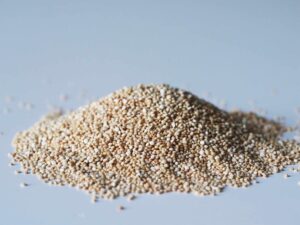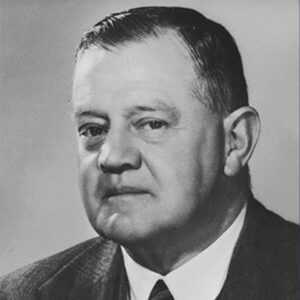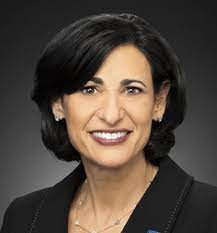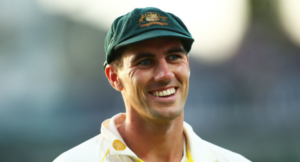I am indebted to the Boston Globe for reminding us of important festivals at a time we might just forget in this world consumed by the Virus.
Last Sunday, Jan. 16, was National Quinoa Day. The so-named food holiday is unlikely to garner as much interest as National Blueberry Pancake Day (Jan. 28) or National Tater Tot Day (Feb. 2) or even Bloody Mary Day (Jan. 1). But if even a little recognition for quinoa and other healthy grains gets us thinking about cooking and eating more of them, then a happy National Quinoa Day would have been attained!

There are about 20 varieties of whole grains; these can take many forms, including whole kernels, cracked pieces, or milled into flour. In addition to quinoa, add wheat berries and its cousin Kamut, bulgur, farro, millet, wild rice, and brown rice.
Whole grains provide crucial nutrition at a low cost. Most grains can be cooked using the “pasta method,” which is to simmer them, uncovered, in a pot of boiling water. Grains like bulgur, quinoa, and millet can be ready in 10 to 20 minutes. Harder, larger kernels, such as farro and barley, if pearled take about 30 minutes; wild rice and brown rice, 40 to 60 minutes; and wheat berries (unrefined wheat) and Kamut (Khorasan wheat – known to be the wheat of the Mummes) can take from 45 to 75 minutes. Older, drier grains need extra time to become tender. Cooking times can be shortened by soaking harder kernels in water overnight.
So, there you are. After honouring quinoa, National Cereal Day is coming up on March 7. Just remember to take your whole grain as well as your bowl of quinoa.
No there is not a Grain of Salt Day, as far as I know. But it would be one of the few substances without his own day of celebration, and while on this topic of celebration of all and sundry, how will those creators of lapel bows cope when they run out of colours?
Albored The Unready?
One of the smartest moves on winning the 1972 election that Whitlam made was his two-person Ministry – he and his Deputy, Lance Barnard. It maintained the momentum of his election win, and the fact that he wanted to jerk a moribund faction-ridden Australia towards some sort of national unity, maintaining momentum. It turned out to be a mirage.
However, his statement on 5 December 1972 is worth reviewing. In it, he assured us that his Government was not mucking around. He ended conscription; he referred the question of colour television to the then protectionist remnant, the Tariff Board, to expedite its introduction; he committed to reversing the previous government’s stance towards equal pay and assured that votes made in the United Nations bore the stamp of his government rather than that of the previous McMahon Government.
During that interim time, Whitlam determined his definitive Ministry in its second iteration announced two weeks later without having the usual concentration on who gets what, who is slighted, who isn’t.
Whitlam’s immediate action is a blueprint for Albanese, who is demonstrating the normal querulous behaviour expected of an Opposition Leader but without raising confidence that he has any policies behind the mask. He unfortunately has a high-pitched voice which quickly can become a whine. And he has seemingly started to adopt the “zinger” of his predecessor, with the same embarrassing timing.
Let us review his approach to the current pandemic which is influencing every segment of government.
He must have on his team somebody who is expert in assuring supply chains, and this includes vaccines, pathology agents, masks and manufacturing. Pharmaceutical manufacture is one area in which Australia is well-placed, with a strong research base coupled unhindered by any massive transport costs. However, there is always another agenda to complicate any decision in relation to manufactured goods. Globalisation is being swamped by the rise of nativist populist politics, with an irrational call back to a past that never existed.
The way Brian McNamee built CSL from being a basket case to its present behemoth status is one example, but then there has been the bionic ear and the respiratory devices for sleep apnoea, all with a strong success story for our applied science.

The role model for the person who spanned these disciplines and was so important for the Australian war effort under both Menzies and Curtin was Essington Lewis. He was very much the person who cut his experiential fangs on assuring a vast enterprise worked efficiently. As the Australian Dictionary of Biography summed up his legacy: By following this precept he had made B.H.P. one of the most efficient steel companies in the world, and his influence was felt in every industry and occupation. His work in munitions was a prerequisite for many of the complex manufacturing ventures developed in Australia in the 1940s and 1950s. There can be little doubt that but for his premonition of war in the 1930s and his rare talents and dedication as an organiser during the war, Australia would have played a lesser part in fighting the Japanese in the Pacific.
Essington Lewis had the confidence of his peers. As the Financial Review once confirmed the above accolade: “There is only one BHP and only one Essington Lewis, mainly responsible for the greatest series of enterprises in Australia, and through them, the greatest single contributor to the defence of the Commonwealth”.
On 25 March 2020 Morrison established the National COVID-19 Co-ordination Commission to oversee the national economic recovery from the COVID-19 pandemic. This Commission was responsible for advising the government on public-private partnerships and coordination to mitigate the social and economic impacts of the pandemic in Australia. It was later stripped of an executive authority to become as an advisory board. To head the Commission, Morrison appointed Nev Powers who, like Essington Lewis, had grown up in the earth of outback Australia, and with an engineering degree rose to the top in the mining and oil industries.
However, unlike Essington Lewis, his relationship with his business interests was never severed and the Government continued to generously subsidise his fossil fuel sector. That, coupled with Powers personally being caught out disregarding the quarantine provisions, just raised more questions about his role with the Commission (later advisory body). The clutch of mediocre bureaucrats that Morrison had assembled around him, meant that in that it did nothing of value. The two years since Powers’ appointment have been strewn with disastrous Government decision making in relation to supply chains.
Let’s face it, Albanese should have an easy ascension given how appalling has been the Morrison stewardship of the health sector. Unlike Whitlam, who had crafted a universal health scheme under the guidance of the able Bill Hayden, with the expertise of John Deeble and Dick Scotton. Albanese does not have an apparent expert team. The team behind Albanese gives little hope of anybody able to initiate action of comparable influence that Deeble and Scotton helped engineer in the 1970s and 1980s. The challenge of the pandemic has placed an unprecedented, immense stress on a system, not only in terms of the allocation of resources, but also the cost – both economic and human.
Therefore, if I were Albanese, I would make a prudent decision to have a blueprint to cope with this altered situation. Governments have been hesitant about custom-built quarantine facilities in each State in the Howard Springs mould. A former senior bureaucrat’s immediate response was to back away from the expense of such facilities. Nevertheless, the nature of this time in the planet’s existence is clear: wave upon wave of viruses mutating just as we believe we have conquered this Chameleon Virus.
At the same time, it is appropriate for Albanese to assert that the Constitutional power on quarantine resides with the Commonwealth – and the Commonwealth alone. As such, the rules of border closures for quarantine purposes can be brought under Commonwealth control. Nevertheless, he should assure Western Australia that any changes will occur co-operatively, and at the same time absorb any lessons learnt by Western Australia’s period of exile (especially the discriminatory regulations in relation to the unvaccinated, which will increasingly be a “live” issue).
Once Albanese recognises that this virus is not short-term, and modifies the views promoted by Government – “rapid antigen tests will be available next month if ever” – “the mañana complex”) or (“we have just about reached the peak of the viral spread” – the Pollyanna complex) – and Albanese should publicly commit to the use of evidence, yet discard the mantra of “deferring to the experts”, when it is clear that this deference is little more than just shifting blame.
 One last piece of advice – look at the past record of potential senior health executives. Look at what constituted a successful health executive in the past – Bernie Amos, William Refshauge, Bernie Mackay, Chris Brook. These are the role models that come to mind. However, beware of anybody who loves Albertan cookies – or the appointment of anybody else from overseas with such expertise.
One last piece of advice – look at the past record of potential senior health executives. Look at what constituted a successful health executive in the past – Bernie Amos, William Refshauge, Bernie Mackay, Chris Brook. These are the role models that come to mind. However, beware of anybody who loves Albertan cookies – or the appointment of anybody else from overseas with such expertise.
Albored the Unready? Part 2 next week.
The story of Rochelle Walensky

Dr Rochelle Walensky was President Biden’s pick to take over the Centers of Disease Control (CDC) in Atlanta after it was almost destroyed by Trump under the hapless Robert Redfield. To get a flavour from Vogue of those times “Health memos from the CDC were being edited by the likes of Kellyanne Conway and Ivanka Trump. Lifesaving practical advice was simply ignored—when the agency sought to issue a nationwide requirement that masks be worn on all public transportation last September, the White House blocked it without discussion.”
There was thus a hidden burden with which Walensky was faced – a disaffected workforce which had suffered the craziness for most of the past four years
Added to this was the face of embattled public health during the Trump years, Dr Anthony Fauci, who had grown old in the public health system, a man of resilience and not inconsiderable ego. Having himself as the public presence of the anti-Trump health forces, he showed remarkable powers of survival.
By comparison, Dr Walensky is an unknown outside health and medical circles. Yet there is still Fauci, who could have reasonably taken a lesser role once Trump was gone and has now been goaded into a sideshow, with a number of Republican senators. Nobody needs that, no matter how Fauci finds it offensive or is in the right. The last person the United States needs now is an ageing controversial figure who is not only polarising the public health debate but is a touchstone for Republican fund raising.
Hence Walensky had been chosen by President Biden to take over the CDC with promises to restore its credibility. With an ever-evolving virus still raging, and the country still deeply divided over the best tools for fighting it, it would not be an easy tenure.
Born in 1969, Walensky grew up in Maryland and after obtaining a BA in molecular biology at the Washington University in St Louis, graduated MD at the Johns Hopkins School of Medicine and MPH from Harvard. As an HIV researcher, her study of clinical effectiveness won her wide praise.
Over 20 years her effect on the formulating and implementation of national HIV guidelines in the United States had contributed to the improved care , testing and outcomes of that disease.
She became chief of the infectious diseases division in 2017 at Massachusetts General Hospital, which put her at the centre of the hospital’s response to the pandemic.
“We’re in an unprecedented time with the speed of Omicron cases rising, and we are working really hard to get information to the American public,” Walensky said recently at that briefing on Jan. 7, describing health care staffing shortages as a harbinger of things to come. “I am committed to continue to improve as we learn more about the science and to communication.”
She has unfortunately been seen as not providing that firm, unequivocal leadership. Her missteps recently have been catalogued by the Boston Globe.
In February 2020, Walensky said vaccines for teachers weren’t a prerequisite for safely reopening schools — a statement the White House quickly downplayed.
In March, she suggested vaccinated people do not carry the virus, something that turned out not to be true and was subsequently walked back by agency staff (inaccurate headlines) generated by her comments, however, are still on the Internet).
In May, as virus cases waned, Walensky told a Senate panel that masks were still key to curbing the spread; then, just days later, she said fully vaccinated Americans could stop wearing them.
In early Autumn, disagreement among the White House, the CDC, and the Food and Drug Administration over who should get booster shots slowed their rollout with Omicron just around the corner. And just after Christmas, the CDC released its shortened isolation recommendations without requiring testing — and without laying out clear enough scientific justification. There was no initial explanation of the science behind the move, leaving experts and the public alike to wonder about its basis.
“In my view, they’re sensible guidelines in a very difficult situation, but they weren’t presented that way,” said Dr. Thomas Frieden, a former CDC director in the Obama administration. “I felt like CDC kind of snatched defeat from the jaws of victory.”
On Jan. 4 this year, the CDC updated the guidance to include more information about testing, and then on Friday, also updated its guidance on which masks best protect against COVID, something many experts said was long overdue.
Some of Walensky’s allies point out that the CDC is frequently scapegoated for larger problems with the government’s approach to public health; the booster issue, for example, involved multiple agencies. One of her supporters said “Many decisions are being made by White House officials, who ‘lurch’ from one haphazard decision to another in the absence of a policy framework.”
Health and Human Services Secretary Xavier Becerra has been conspicuously absent from the government’s public-facing COVID response and largely escaped media scrutiny; Fauci, Biden’s chief medical adviser who is often quick to step into the spotlight, has at times publicly contradicted Walensky.
Her task is thus not easy. The ability of political, content-free advisers who have emerged from the caves of public relations are the pestilence in destroying evidence-based advice. Take Kerry Chant, the NSW Chief Health Officer, and having been a critic of her early missteps, I must admire her willingness to plant sensible suggestions with the community in the face of the Premier’s hare-brained approach.
The Undefinable Quality of Pat Cummins

Pat Cummins has that undefinable quality of leadership. Leadership demands authenticity and consistency in decision making. Cummins has inspired a group known for insensitive arrogant larrikinism to realise that this is not a productive role in a world convulsed with the Virus. It is the time for the hero; not the anti-hero.
There is always a concern that the qualities that make an exceptional cricketer do not translate into a sensitive leader as Cummins is showing. The fact that he is regarded as the best fast bowler in the world is the product of early success at Test level and then years of battling injuries caused by the stresses of bowling at the highest level. Natural talent fortunately conquered disability, but the demands on the body remain, especially as with age the joints are the first to feel the pressure.
Yet at the end of an over he has just bowled, Cummins does not just wander back to the boundary to recuperate. As captain he cannot rest, he must remain concentrated on the state of play; one testimony to Cummins’ judgement has been the number of successful reviews of umpire’s decisions during the recent series.
Then at the conclusion of the last Test, there was the “Khawaja incident” – Cummins’ immediate response snuffed out any potential controversy or calls of racism. More than anything, this incident highlighted the generosity of spirit that he possesses. This quality of leadership has brought into relief the limitations in Justin Langer’s ability to coach.
Langer may have been a very good opening batsman, but the qualities that made him that were not endearing to the community at large where he was treated with dislike. He has never demonstrated the same generosity of spirit. He was once called a “brown-nosed gnome” by a Wisden employee. Despite the furious reaction at the time by Cricket WA and Wisden’s apology, Langer had never achieved the trusted status of Cummins.
Cummins’ gesture towards Khawaja reminded me of the time not so long ago when I was director of clinical training in a number of health services in the North-eastern part of Victoria. There were several Muslim doctors from various countries, but also in a certain town there was a community of Marsh Arabs, Shiite refugees from Southern Iraq. Nevertheless, they were not the only Muslims. Decades ago the Goulburn Valley had settled Muslim Albanians who now owned some of the orchards. They are mostly Sunni. There were both Sunni and Shiite doctors in the community.
Apart from dealing with clashes in regard to treatment of women and ensuring prayer facilities were available for the devout, who pray five times a day, two other challenges emerged.
The first was circumcision. As a result of some zealous lobbying by paediatric professionals, the Victorian government had banned male circumcision in its public hospitals, except for three medical conditions. A more measured view has been provided elsewhere. It may be that the best interests of a child in relation to circumcision are different for a Jewish or Muslim boy than a child receiving a non-religious circumcision … ritual male circumcision is of special importance in Judaism and Islam. A child who is not circumcised may feel psychologically and spiritually cut off from his religion and culture.
Faced with the lack of information and a hostility to the procedure, one case reported to me was of a Muslim having difficulty in arranging for the children in the community to be circumcised. One male child had even been taken back to Iraq for circumcision. One of the Muslim doctors, a woman with Syrian post-graduate qualifications in paediatrics, raised this question with me and as a result a seminar was convened of a cross-section of health professionals to discuss the matter.
The meeting included a number of influential doctors, who had supported the ban. It was clear that the plight of the Muslim population had not been considered. The meeting highlighted this deficiency in cultural consideration. One of the local doctors, who did not have any of the paediatric zealotry, agreed to it being known that he would be willing to circumcise Muslim children. After all, it had not been that many years since the majority of the male population was routinely circumcised.
This solved an immediate cultural problem there and subsequently circumcision clinics with ritual circumcisers have sprung up in Victoria, as has been the case in the Jewish community for years.
The second was lack of appreciation of Ramadan. One of the young female interns provided a seminar on the subject, after a worried senior doctor noted one of the younger doctors neither drinking nor eating during the day and asked what was wrong.
So, this and her subsequent seminars raised awareness of Ramadan, and that the time of Ramadan shifts from year. Over the years when she was in the North-East she would give a presentation before Ramadan was due to begin. These presentations were well received. I helped facilitate her setting up the first seminar, but that was years ago – and how permanent are such initiatives?

My thesis is that every scrap of positivity counts in translating awareness into understanding to a shift in attitudes and ultimately behaviour to a more tolerant Australia.
Cummins could become a very influential figure in the absorption of Muslim culture into mainstream Australia. I am old enough to remember when Jews were considered to be a separate cultural strand, counterpointed by the number of prominent apostates adopting Christianity and thus bowing to a social norm prompting a change in belief. Just stand back in Melbourne, my hometown, and recognise by and large how times have changed with pride in our Jewish diaspora. No reason this should not occur with our growing Muslim community.
Anti-semitism, whether against Jew or Muslim, still is an undercurrent in our community.
That interaction – that gesture – between Cummins and Khawaja however small in the order of things, may it extend to become the normal societal and cultural expectation within the Australian community.
Mouse Whisper
This comment, from a Professor of Palaeobiology, Jan Zalasiewicz, who was part of the Anthropocene Study Group, writ large in the New Scientist nearly 25 years ago resonated with yon mouse:
“The signature we have left in sediments extends across large parts of the world, and is being carried into deeper seas.
So, with a favourable concatenation of tectonics and sea level, our species could leave behind in a geological instant a much more striking record than the dinosaurs left in a hundred million years. It is a prospect that speaks volumes about the way we have engineered the face of the planet over a few short centuries. The super intelligent, geologically aware rodents of the future, stumbling upon the newly uplifted substructure of, say, New Orleans or Delhi, would see evidence of aggressive colonisation unmatched anywhere in the geological record.”
Rodents of the future? And geologically aware? And intelligent? To what can we look forward?

